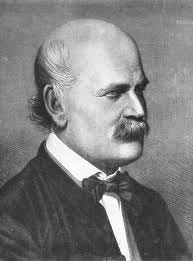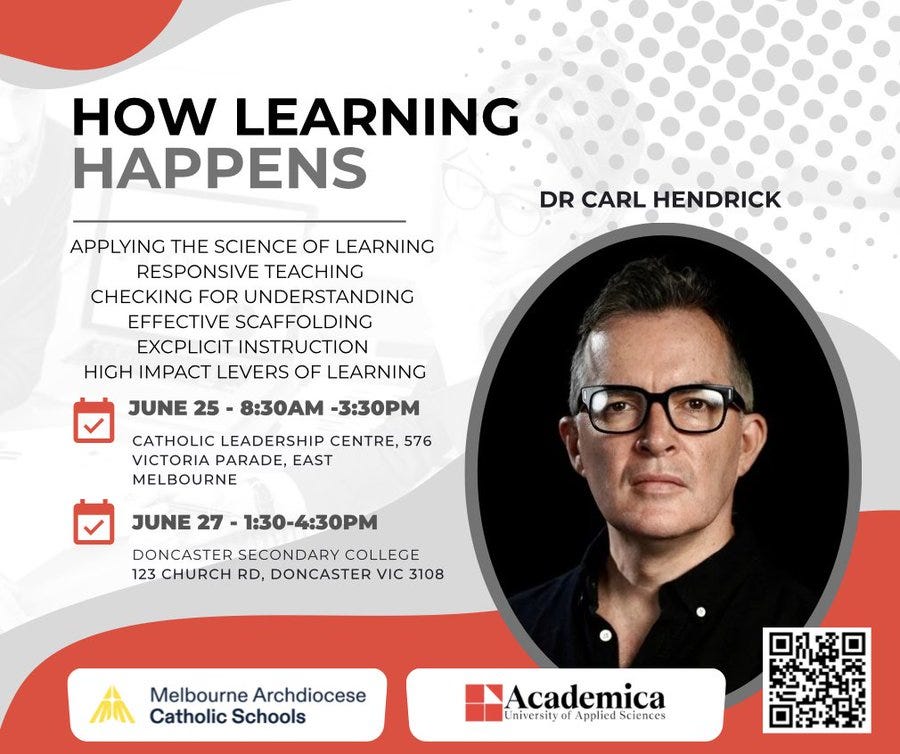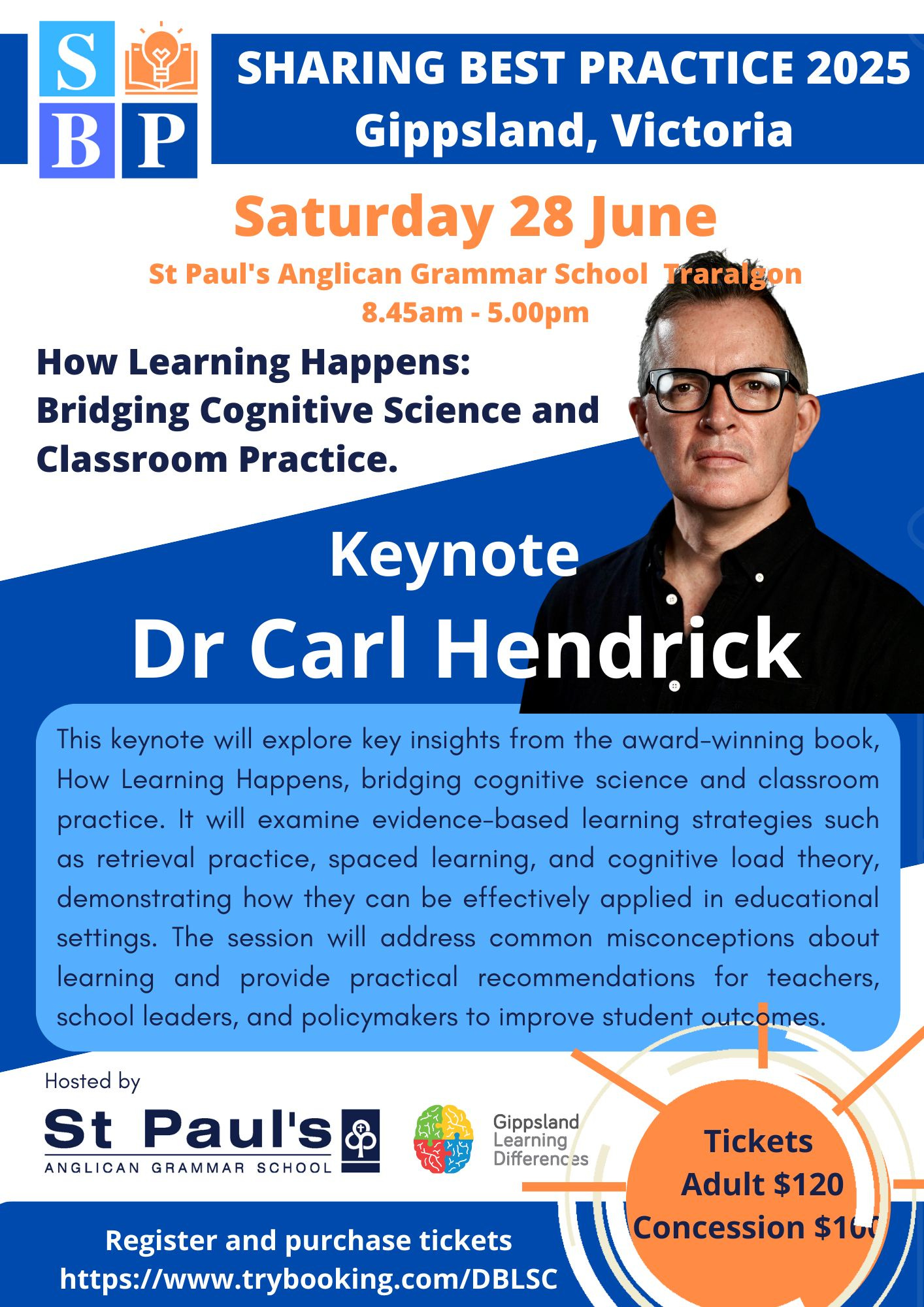Top-Up Tuesday: Five Things Every Teacher Should Do
What Dr. Carl Hendrick wished he knew at the start of his career
As teachers, we're constantly seeking ways to improve our practice and most importantly, help our students truly
learn. We encounter a wealth of educational research, but the perennial question remains: "Okay, that all sounds great, but what does it mean for me?".
Dr. Carl Hendrick is someone who has dedicated his career to bridging this exact research-to-practice gap. Drawing on his own journey from starting in a challenging school in 2006, navigating teacher training that was only partly helpful, and eventually discovering the power of cognitive science five years in, Carl now works to make these crucial insights accessible to educators worldwide.
In a recent conversation, Carl shared five key areas he believes every teacher should understand to enhance their effectiveness in the classroom. These are the things he wished he knew in his own early career, the kind of knowledge that moves beyond fumbling in the dark or trying to "con kids into learning".
Let's delve into these five essential insights:
1. Be Open to Powerful Evidence
One of the biggest hurdles educators face is a natural resistance to evidence that challenges existing beliefs or practices. Carl draws a powerful historical parallel to Ignat Semmelweis, the Hungarian doctor in the 1840s who discovered the importance of handwashing in preventing puerperal fever in maternity wards. Despite clear experimental evidence, the medical community was outraged; they reacted instinctively with the "Semmelweis reflex," recoiling from evidence that didn't fit their worldview ("doctors are gentlemen and gentlemen's hands are clean"). Semmelweis's story is a cautionary tale of intransigence in the face of life-saving truth.
Carl argues education is at a similar stage, facing "very obtuse resistance" to cognitive research. While philosophy is important, practical guidance is needed for teachers in the classroom. Cognitive science offers "really, really unequivocal guidance" on how to make learning stick long-term.
A key area where Carl changed his mind is minimally guided instruction. Initially, he believed students learned best by discovering things themselves. However, drawing on evidence from cognitive science, he realised this is often ineffective for novices. Novices and experts don't just learn differently; they think differently and see problems differently. Experts can efficiently convey vast amounts of information to novices. Instead of trying to "trap" or "con" kids into learning, Carl realised he needed to "just tell them stuff initially," modelling not just content but also how to think about it and demonstrating passion for the subject.
Another shift was understanding that learning is "totally illusory," almost imperceptible. It's not something easily gauged by a quick check ("Everyone happy with that? Yeah?") or assuming feedback from the top students indicates understanding. Lessons that look impressive ("Cirque du Soleil kind of showpiece lessons") can have "high engagement with low learning". The science of learning helps us move beyond these illusions and put in place strategies that lead to long-term learning.
2. Embrace Retrieval Practice
Carl highlights retrieval practice as a fundamental principle rooted in the testing effect. The core idea is that when you retrieve stuff from your long-term memory, it leads to greater long-term gains.
Contrary to the idea that memory is like a tape recorder, it's actually reconstructive. Every time we retrieve knowledge, we're relaying down and strengthening that connection. For the vast majority of knowledge taught in school (times tables, spelling, equations), this repeated re-encountering is how it sticks. Simply telling students information is not enough long-term.
Carl advocates for a shift from asking students "if they've learned something to asking them what they've learned". This forces them to reconfigure their memory, gives the teacher a clear picture of understanding, and guides next steps.
While methods like quizzing, questioning, and mini whiteboards are valuable, Carl warns against "lethal mutations" of retrieval practice. It's not enough to just do a "daily review" or "do now" at the start of a lesson. We need to consider interleaving and spaced practice.
Interleaving means varying the conditions of retrieval to make it slightly more difficult in the short term, leading to greater long-term gains. Crucially, the biggest mutation of interleaving is thinking it's mixing up topics or subjects. It should be applied to material you've already learned, not new content. Interleaving involves variations within a particular topic, not completely different songs. This requires teachers to plan carefully to present "similar looking problems" where students have to think hard to choose the right solution.
This links to the concept of desirable difficulties from Robert and Elizabeth Bjork. Things that are difficult in the short term are desirable for long-term gains, like the "no pain, no gain" of exercise. Activities that feel easy or fluent, like highlighting or rereading, often don't lead to long-term learning. Closing books and actively retrieving knowledge feels harder but is more effective. We accept this discomfort for physical health, and we should apply the same principle to learning.
3. Prioritise Checking for Understanding
For Carl, checking for understanding (CFU) is arguably the "one lever that could really affect and kind of supercharge learning" in a school. It's the principle of constantly knowing what students know and, more importantly, what they don't know, gathering "rich data regularly throughout their learning". This moves away from a "deficit model" where teachers only discover gaps much later (e.g., weeks after teaching, via an essay).
Drawing on frameworks like Explicit Direct Instruction (EDI) and the work of Madeleine Hunter, Carl suggests checking for understanding literally every five minutes in some lessons. The key is to move from "does everyone understand this?" to "what do you understand?".
Carl outlines a five-dimensional matrix for thinking about CFU:
Timing: When do you check? Ideally, even before you start teaching a topic, as a pre-check to see prior knowledge. Then, regularly throughout the lesson.
Modality: How are students showing their understanding? Drawing, talking, saying, writing? Mini whiteboards are a highly effective modality, allowing teachers to scan the room and get rich, real-time data from the whole class.
Participation Structure: How are students participating? Alone, pair share, group? Teachers can adapt this based on the class, e.g., using pair share for less confident students or cold calling for others.
Means of Participation: (This dimension seems intertwined with the structure and specific methods chosen, like think-pair-share or choral response).
Teacher Response: Crucially, what do you do with the data? How do you adapt your teaching based on what students show?. CFU helps teachers make informed "course corrections" instead of rushing on when students haven't grasped something. It also helps teachers reflect on their own instruction when students struggle.
CFU is not just assessment; it's also an engagement tool and culture builder. When done well, it makes students feel valued and part of a community. It breaks up teacher talk, helping manage working memory limitations, and provides actionable data. Carl stresses that these CFU techniques need to be taught explicitly as routines. Teaching routines saves time and signals that learning time is valued.
4. Insist on Alignment of Curriculum and Assessment
Carl identifies three essential levers for long-term learning: what we teach (curriculum), how we teach it (instruction), and how we know they've learned it (assessment). Drawing on John Biggs' concept of constructive alignment, these three elements must be in sync.
Historically, Carl observed a lack of alignment, with teachers often planning activities rather than focusing on core knowledge, and assessments being skills-based rather than knowledge-based. He now advocates for expert-designed curriculum rather than individual teachers creating their own schemes. Teachers are primarily teachers, focused on the complex task of meeting the needs of students in front of them, not necessarily instructional designers creating cumulative, systematic curricula from scratch. An expert curriculum provides a strong foundation or "song by Bob Dylan" that teachers can then "do in their own style". This frees up teachers from the "grind" of planning, allowing them to focus on the crucial work of teaching and interacting with students.
Alignment is difficult because curricula are often not explicit about what students need to learn, lack cumulative design, and contain too much content. Furthermore, instruction is the curriculum; time needs to be factored in for retrieval, interleaving, and checking for understanding, which impacts pacing.
Carl believes AI will be transformative in aligning these elements by automating tasks like curriculum design, planning, marking, and reporting – tasks that are highly complex and time-consuming for teachers. This would strip away the "rubbish" of the job and allow teachers to focus on what AI cannot do: inspiring, enthusing, supporting, and building relationships with students, and modelling a love for their subject.
5. Embrace the Illusion of Instruction
Carl's upcoming book (co-authored with Paul Kirschner and Jim Heal) explores the idea that cognitive science often reveals a paradoxical relationship between instruction and learning. To achieve a desired outcome, you often need to do the opposite of what seems intuitive.
For example, if you want independent learners, you might think you should start with independent learning. However, the paradox suggests that to get independent learners, you need to start with clear, explicit instruction. Similarly, problem-solving doesn't automatically make you better at problem-solving; deep underlying knowledge of the problem's structure does.
This leads to the illusion of instruction: things that feel easy or engaging in the short term may not lead to long-term learning. The feeling of fluency or competence ("I know this") can be misleading. Activities where students are engaged but simply practicing what they already know might not lead to new learning.
True learning, especially at the novice stage, often involves desirable difficulties – tasks that are a little uncomfortable or confusing in the short term but build deeper understanding and skills for the long term. Just as an elite swimmer looks smooth after years of hard, uncomfortable training, learning feels easier and more fluent after the hard work of acquisition and retrieval. Teachers need to understand that expecting constant smiles and easy progress during the initial learning stages is often an illusion.
Moving Forward
These five insights – being open to evidence, utilising retrieval practice, constantly checking for understanding, ensuring curriculum and assessment are aligned, and understanding the paradoxical nature of instruction – offer a powerful lens through which teachers can view their practice.
To help teachers develop a "shared understanding" of these principles, Carl and colleagues have developed the How Learning and Teaching Happens eLearning course, based on their popular books. This online course aims to provide accessible, flexible professional development on the core principles of cognitive science for schools and teachers.
By focusing on these evidence-based principles, teachers can move beyond assumptions and intuition to make truly informed, adaptive decisions in the classroom, ultimately creating the conditions for all students to experience that crucial sense of achievement.
You can listen to the full episode with Dr. Carl Hendrick 👇
Carl will be here in Australia in June. Here are some of the places that you can catch him:












This is great thank you!